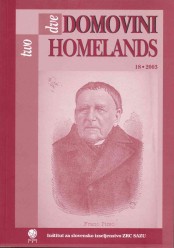SLOVENIAN IMMIGRATION IN THE INTERWAR PERIOD
Abstract
Among the immigration countries of the world is Argentina, which took in millions of European migrants. In the late 19th Century and thereafter this country offered economic promise, thanks to fertile lands appropriate for growing cereal crops and raising beef cattle, for export. In response to a labor shortage, successive Argentine governments encouraged the arrival of immigrant groups to populate the vast interior. While the Argentine economy looked very promising, the Slovenian population suffered the political and economic consequences of the First World War. So the search for new horizons was a response to political oppression and unbearable poverty and social marginality. The largest flows of these immigrants were recorded between 1923 and 1928. Thereafter the number began to decline because the worldwide economic crisis and the resulting mass unemployment put a stop to migratory flows.
The integration process into Argentine society was very difficult. The unknown language, the very different customs, and the unavoidable need to start again from scratch were burdens that weighed heavily on the lives of the new arrivals. Though most Slovenians came from rural backgrounds, the majority of them settled in Buenos Aires, which had become the great magnet because it offered the broadest range of employment opportunities.
In response to the difficulties of the first stage of integration into Argentine society, stemming from the environmental and cultural differences, it was of the utmost importance for the members of the "collectivity" to have these channels for maintaining friendship and solidarity, in the form of cultural and mutual aid societies. This was a basically social organization, which held festivities and sporting events that helped cement the ties among the immigrants, in addition to providing assistance to members of the community in times of trouble. They made it possible to conserve a certain unity and cohesion among the residents of Slovenian origin, establish social relations within the community, and thereby preserve some aspects of their age-old cultural identity.
Downloads
Downloads
Published
How to Cite
Issue
Section
License

This work is licensed under a Creative Commons Attribution-NonCommercial-NoDerivatives 4.0 International License.
Authors guarantee that the work is their own original creation and does not infringe any statutory or common-law copyright or any proprietary right of any third party. In case of claims by third parties, authors commit their self to defend the interests of the publisher, and shall cover any potential costs.
More in: Submission chapter





